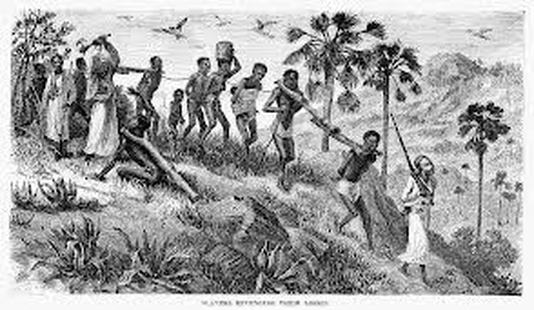The Colombian and the impact it had on the Eastern Hemisphere
Political and Social Impact of Slavery
The largest Impact the Colombian exchange had on Africa, was the slave trade. Due to the nature of the slave trade various African tribes were sucked into a cycle of necessary slave trade. When the Europeans arrived to trade in Africa, they would exchange European technologies such as guns for African slaves. These guns would give African tribes that exchanged with the Europeans a technological and military advantage over rival tribes; Thus made it easier for tribes with guns to defeat the tribes without and acquire more slaves. This put many Africans in the position of either "kill or be killed." If a tribe wasn't acquiring technology through slave trade then they would be conquered by those who did. Resulting in viscous cycle that forced Africans to fight and enslave rival tribes.
Impacting Food
Food had a large impact on the east, especially in Europe where many foods that have become icons of countries began. The Colombian brought tomatoes to Italy, chocolate to Belgium, and tobacco to France. These new crops and foods increased the food supply of Europe allowing them to continue to expand into the west. Europe of course was not the only people to adopt new crops, China took on the sweet potato while West and Central Africa began to grow peanuts and cassava which increased their food stuffs. The three main crops that helped to stifle starvation would be corn, potatoes, and cassava. These foods created more balanced diets for people in the east as well as creating new products in agriculture, thus increasing their life expectancy and quality of life. Their were not any domesticated animals of real value to take back from the Americas although their lack of beast of burden allowed for another food to be shipped to the west- meat. The people of the east could trade beef and pork with the natives as well.
Intellect/Ecology
Ecology is the study of the relationship between people and the environment. It focuses on the changing of ecosystems, decomposition, biodiversity, and the preservation of the number of organisms. This was a concept that was very prevalent with the Native Americas but no longer existed in Europe since the time of great Philosophers such as Plato and Socrates. Since interacting with Natives through the Colombian exchange Europeans retained the intellect and knowledge of ecology and helped Europeans adjust there environmental ravaging, and become more educated and conservative with their impact on ecosystems.
Economic Impact
The economic impact of the Colombian exchange is undeniable. It opened up many new trading partners for all countries, especially Europe who was in desperate need of trade. It opened up many trading posts as well as led to the creation of many major companies such as the Dutch West Indie co. This is the first step in creating a global economy where everyone is connected to each other through the trade of goods; being in this case mainly slaves, crops, and simple trinkets.
Works Cited:
http://www2.palomar.edu/users/scrouthamel/colexc.htm
http://people.cohums.ohio-state.edu/odlin1/courses/571/columbex.htm
http://www.kwintessential.co.uk/articles/colombia/Columbian-Exchange/5062http://en.wikipedia.org/wiki/Columbian_Exchange
http://people.cohums.ohio-state.edu/odlin1/courses/571/columbex.htm
http://www.kwintessential.co.uk/articles/colombia/Columbian-Exchange/5062http://en.wikipedia.org/wiki/Columbian_Exchange

